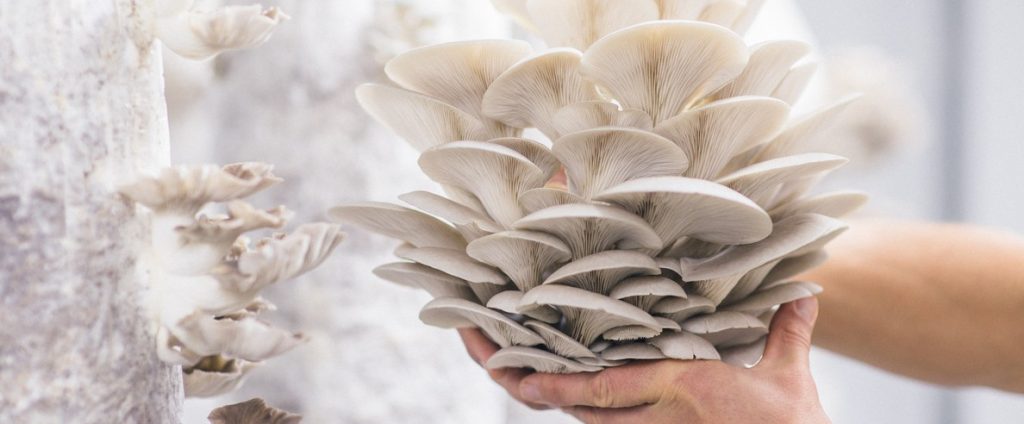Growing mushrooms can be a very enjoyable way to earn a living.
The problem is that there’s a lot to learn. Without creating a proper mushroom growing business plan, it’s hard to be sure that you understand everything that’s required.
To have a successful mushroom farm, you’ll need to understand the production costs and overhead expenses of running your business.
Plus, you’ll need to understand who your competitors are and how to price your product.
Thankfully, creating a plan for growing mushrooms isn’t difficult once you know what it needs to include.
In this article, we’re sharing a mushroom growing business plan model and everything else you’ll need.
But first, let’s discuss whether a mushroom growing business makes sense for you.

Is a Mushroom Growing Business Right for You?
Not everybody is an ideal candidate for a mushroom growing business. Here are some signs that growing mushrooms is right for you.
You’re highly motivated and self-driven. For any kind of entrepreneurial venture, your success or failure depends entirely on you.
For your mushroom growing operation to survive and grow, you’ll need to be willing to devote a lot of time and energy to your mushroom growing business.
You love working with your hands. Any kind of farming is quite physical work and mushroom growing is no exception.
You’ll be getting dirty and lifting heavy things pretty much on a daily basis. So it’s not a suitable career for someone who wants a desk job.
You already have some experience growing mushrooms.
Before you start growing mushrooms on any kind of large scale, you should’ve already successfully grown smaller batches of mushrooms.
Not only will this help you to learn more about the mushroom growing process, but it’ll help you to figure out if growing mushrooms is really what you want to do full-time.
You’re comfortable working several different roles. When you start your mushroom farm, you probably won’t have the money to hire staff.
You’ll be preparing substrate, harvesting mushrooms, cleaning, placing orders and many other tasks all by yourself.
You enjoy dealing with people. To run a successful mushroom farm, there’s more than just growing the mushrooms.
You’ll also need to network and market your product to chefs, wholesalers, buyers at farmer’s markets and more.
How Do I Start a Mushroom Farming Business?
When you’re first starting a mushroom growing enterprise, there are a number of factors to consider.
Why do you want to do it? Are you passionate about farming or growing mushrooms? Do you think it’ll be very profitable?
It’s important to figure out your motivations for starting a mushroom business.
What will you be selling? We recommend starting off by selling oyster mushrooms because they’re easy to grow. Then you can branch out into growing shiitake, lion’s mane and other varieties as well.
However, it’ll also depend on what kind of mushrooms there’s a demand for in your area.
What are the market conditions in your area? Are there any existing mushroom businesses in the area that you’ll be competing with? If so, how will you differentiate yourself from them?
If mushroom growing is already highly competitive in your area, you may even want to consider relocating to somewhere with less competition.
Who are your potential customers? How many restaurants, grocery stores and other customers are in your area that will want to buy your mushrooms?
Large cities will have more customers, but also more growers to compete with. Smaller cities may not have enough demand to support your business.
Large-scale growing vs. small-scale growing. Large-scale mushroom farmers tend to focus on growing button mushrooms, cremini and portobello mushrooms.
They can make lots of money by supplying large national grocery chains, but there’s also a large upfront investment in terms of equipment and staff.
At GroCycle, we focus on small-scale mushroom farming.
What are your finances like? Do you have the required money to invest in starting your mushroom business, or will you need to get a loan?
Have you worked out the prices you will charge or the amount of mushrooms that you expect to sell each week?
How Much Does It Cost To Start a Mushroom Farm?
You may be able to start a very small mushroom farm with just a small investment.
There are a lot of factors to consider when it comes to the finance side of your mushroom growing business.
Production costs – This includes the cost of buying spawn, substrate, grow bags, disinfectant, gloves and other consumables that you’ll use in your business.
The more mushrooms that you grow, the more of these things you’ll have to pay for.
Business overheads – This includes things like rent, taxes, telephone bills, utilities, employee labor and interest on loans.
You’ll need to pay for these things regardless of how much — or little — you’re producing.
It’s difficult to give an estimate of how much it will cost you to get started. Everyone’s situation is different and costs can vary a lot.
Someone who is starting off in a shed or garage that they already own might only need to invest in the equipment and materials that they’ll need.
When you’re designing a Low Tech Mushroom Farm, you may be able to repurpose a lot of space and equipment that you’ve already got.
Larger mushroom operations in the heart of big cities like New York or London may need to pay thousands of dollars per year in rent alone.
The more you grow, the more your materials will cost as well.
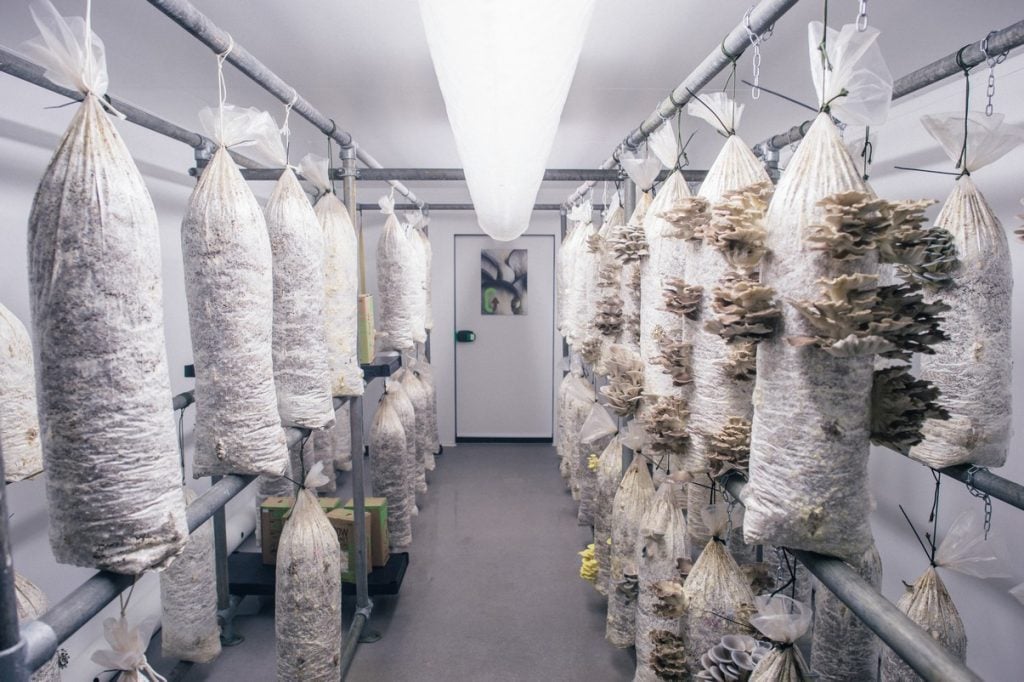
What Prices Should You Charge?
Depending on where in the world your mushroom business is located, we’ve seen oyster mushrooms range in price from about $5 to $15 per pound, or £7.50 to £24 per kilo.
If you’re selling directly to customers, you may even be able to charge more than that.
The existing market in your area will largely dictate how much you can charge for your mushrooms.
In an area with lots of competition, you may need to offer your mushrooms at a slightly lower price.
Although if your mushrooms are fresher and of higher quality than your competitors, then you can still charge more for them.
Budgeting for Your Mushroom Business
Running any type of business requires careful budgeting and mushroom growing is no exception.
You’ll need to work out the cash flow for your business as well. This is all of the expenses and income that will flow in and out of your business in a given week, month, or year.
Obviously, you’ll want more money coming into your business than going out, since you’re trying to earn a profit!
In the beginning, you may not be able to create a completely accurate budget or cash flow plan. But it’s important to research as much as you can and try to get it as accurate as possible.
You don’t want to be surprised later when it costs you twice as much to run your business as you had expected.
Creating a Mushroom Growing Business Plan
Making a budget and figuring out what your cash flow will look like is just one part of a business plan.
A good business plan will also help you assess your competition, create a sales and marketing strategy and much more.
If you want to get a loan from a bank, they will almost certainly want to see a business plan.
This shows them you’re serious about the business. And that you’ve thought out all of the pros and cons.
A business plan also helps you to figure out if it’s realistic that you can turn your mushroom growing operation into a profitable business.
If you create your business plan and realize there’s no way to be profitable given the costs or demand in your area, it may be worth quitting while you’re ahead.
We recommend checking out a sample template on how to write a mushroom farming business plan, which you can find here.

How Much Investment Do You Need for a Mushroom Farm?
For a small Low Tech Mushroom Farm, we recommend having an investment of at least $2,000 or £1,500 to get started.
It’s a fairly lean budget, but with some creative planning, you should be able to make your money stretch and get everything you need to start growing mushrooms.
You can always start with just the bare essentials to start with and then add some “nice to have” items later as your business starts to grow.
We discussed some of the costs of setting up a mushroom growing business above.
Now let’s go into some more depth in terms of factors to consider.
1. Space required. 1 ft2 can produce anywhere from 7 to 25 lbs of mushrooms per year. 1 m2 can produce 35 to 125 kg of mushrooms per year.
On our own farm, we’ve found that we can produce toward the high end of those amounts. But that includes only productive space.
Depending on how much room you want to leave for walkways and other empty space, your production may be closer to the low end of that range.
2. Water required. To grow 1 lb of oyster mushrooms will require 1.8 gallons of water. That’s the equivalent of 15 liters of water to grow 1 kg of mushrooms.
That amount of water includes grow room humidification, substrate hydration and pasteurization, plus cleaning.
This is much less than pretty much any other crop, so the water costs will be negligible.
3. Energy required. Growing 1 lb of mushrooms requires about 1 kWh of energy. 1 kg of mushrooms will require 2.2 kWh of electricity.
Want to try growing mushrooms outside to cut down on costs? Our article How To Grow Mushrooms Outdoors With A Mushroom Bed explains how.
4. Location. Your location costs can range from $0 if you’ve already got somewhere to grow, up to thousands of dollars in rent per month.
We recommend starting small and perfecting your processes before renting a large space for your mushroom growing business.
5. Labor. If you want to hire staff, you’ll need to pay a minimum wage dictated by your government.
There are other payroll costs such as employment insurance and taxes to consider as well.
You can cut the labor cost by going into business with one or more partners instead of hiring staff.
That way you split profits that the business generates, as opposed to paying an hourly rate.
6. Time commitment. Even a small mushroom growing business will take hours of your time each week.
You’ll need to prepare substrate, monitor mushroom growth, harvest and clean on a regular basis.
There’s an opportunity cost associated with any time you spend growing mushrooms, that you could be using for something else.
7. Licenses and permits. Your federal or local government may require you to have certain licenses and permits to run a business or grow food.
Check what your local laws are. These may add up to a few hundred dollars or pounds per year.
8. Packaging. You’ll need some way to package your mushrooms.
Depending on your customers, you may need bags, plastic containers, cardboard boxes, or some other way to display and transport your mushrooms.
Poly or cellophane bags will only cost a few cents each. Plastic clamshell containers may cost $0.10 to $0.25 (7p to 20p) each.
9. Marketing. Customers need some way to find out about your business.
These costs include things like setting up a website, decals for vehicles and banners for your table at farmer’s markets.
You may also want to advertise on social media, or via local radio or newspaper ads to let people know that you’ve got mushrooms for sale.
Expect to invest in advertising materials upfront and on an ongoing basis each month.
10. Record keeping. You’ll need some kind of accounting or record keeping software to keep track of all of your purchases and sales.
Programs like Quickbooks or Sage Accounting will cost you a few dollars per month, but will make the administration side of your business much easier.
You may also want to pay to have an accountant prepare your taxes each year. They can often save you more in taxes than the fee that they charge.

Supplies Needed
There’s a wide range of different supplies you’ll need to get your mushroom farm up and running.
- General tools. This includes things like a mop and bucket, screwdrivers, electric cycle timers, a humidifier and a respirator. Most of these items can be bought at a local hardware store.
- Materials to create your utility, inoculation and fruiting rooms.
This includes things like vinyl flooring or waterproof floor paint, a sink, plumbing pipe, a 45 gallon food grade steel drum, shelving, lighting, fans and more.
These items can be bought at a hardware store or builder’s merchant.
- Substrate. You’ll need to decide if you want to grow on cardboard, sawdust, coffee grounds, or some other substrate.
Then figure out where you can source them locally in a cost-effective way.
- Mushroom spawn and grow bags. These items should be bought as locally as possible.
Particularly for fresh mushroom spawn, you want to minimize the travel time as much as possible.
That way you’ll end up with a healthier and less stressed out spawn. Look for suppliers in your region, state, or province first.
Then expand to a country-wide search if you can’t find anything more local.
See our article How to Grow Mushrooms in a Bag to learn the growing process.
Is Mushroom Cultivation a Profitable Business?
Cultivating mushrooms can be very lucrative and profitable. On our small mushroom farm, we’ve been able to generate more than $200,000 (approximately £150,000) in sales per year.
The typical production cost for oyster mushrooms is about $2 per pound. You can sell those same mushrooms for $12 to $20 per pound (£3.20 to £5.50 per kilo).
In other words, you’re getting anywhere from $6 to $10 of profit out of your business for every $1 that you put in.
For a full breakdown on how to run a profitable mushroom business, check out this video:
Different Mushroom Products You Can Sell
Do you want to really take your mushroom growing business to the next level? One way to really increase your sales is to broaden the types of products that you’re offering.
There can be a fine balance here, as you don’t want to put too much work into producing a giant catalog of products.
But we recommend experimenting with these to see which will generate lots of sales in your particular area.
- Fresh mushrooms. This is the most basic way to sell your mushrooms. This doesn’t require any time to produce a value-added product like the other items on this list.
Simply harvest your mushrooms and pack them up.
- Dried mushrooms. Dried mushrooms are particularly good if you find that you’ve got a surplus of fresh mushrooms in any given week.
Fresh mushrooms have a short shelf life. Drying them can extend their shelf life to weeks or months.
- Mushroom jerky. Adding some soy sauce, vinegar and spices to your dried mushrooms can transform them into mushroom jerky.
This specialty product is increasing in popularity with vegetarians as an alternative to beef jerky.
One pound of mushrooms will dry down into about three ounces or 85 grams of mushroom jerky once most of the excess water has been removed.
But you can sell this amount of mushroom jerky for $12 (£8.75) or more.
- Other mushroom snacks. You can get creative and come up with your own types of mushroom snacks to sell.
Everything from mushroom crisps to meal replacements can do well with health-conscious customers.
- Supplements. Medicinal mushrooms like reishi or lion’s mane can be dried, powdered and put into capsules.
- Mushroom kits. Selling mushroom kits allows people to enjoy watching mushrooms grow in their own home.
It also makes your job easier and shortens the growing cycle, since you won’t need to fruit them yourself.
- Ready-to-fruit substrate. Supply other growers in your area with substrate and allow them to grow their own mushrooms.
Be aware that you might be creating more competitors for yourself if you decide to go this route!
Although if you find you prefer mixing and bagging up substrate compared to incubation and fruiting, you could turn this into an entire business on its own.
- Mushroom farm tours. Farming mushrooms is seen as a quite rare and mysterious business. Many people may never stop to think of where mushrooms come from.
Children and adults alike may want to come visit your farm and see what your day-to-day operations look like.
Consider adding a small gift shop at the end where they can buy mushrooms, kits and other products.
- Educational workshops. Schools and day camps may be willing to pay to have you come in and give a demonstration on how mushrooms grow.
Or a teacher may make it into a field trip for their students to come visit you.
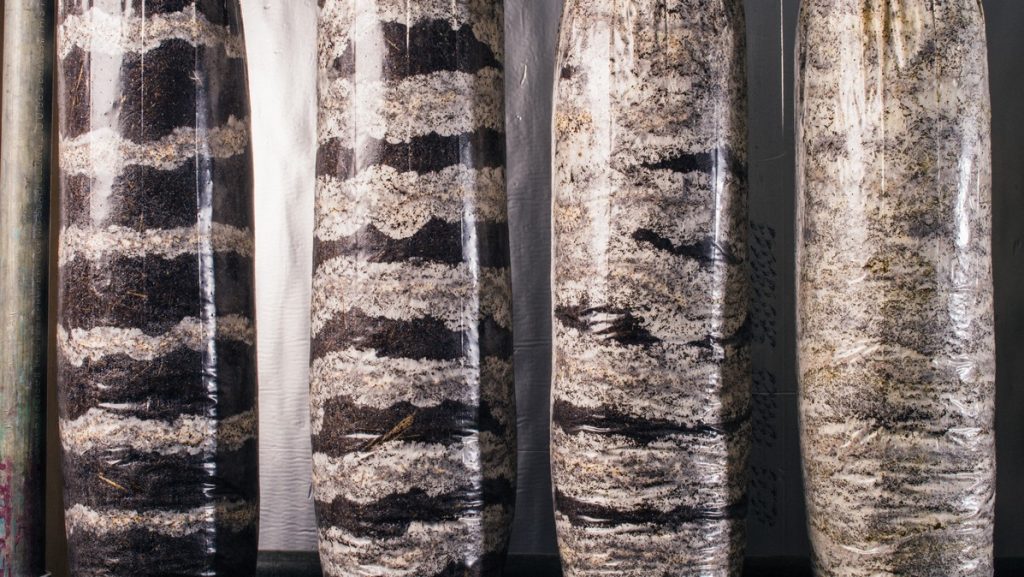
What Conditions Are Needed for a Mushroom To Grow?
Mushrooms require different conditions depending on which stage of the growing process they’re at.
Your mushroom growing business will need a mixing and inoculation space, an incubation room and a fruiting room.
A mixing and inoculation space is any clean area where you can mix mushroom spawn with substrate and place it into bags.
The conditions in this room just need to be comfortable for you to work in.
The incubation room should be dark with a temperature between 20 to 24 C (68 to 75 F). High CO2 content is an added bonus.
This is where the mushroom spawn will colonize the entire substrate in preparation for fruiting.
Once your mushroom grow bags are completely colonized, they’re moved to a fruiting room.
The fruiting room should have 80 to 90% relative humidity.
The mushrooms also need some lighting to trigger pinning and fruiting. Either LED rope lights or fluorescent lights in a waterproof housing will work.
A fruiting room also needs lots of air exchange. You’ll need fans to bring fresh air in and pump CO2 rich air out.
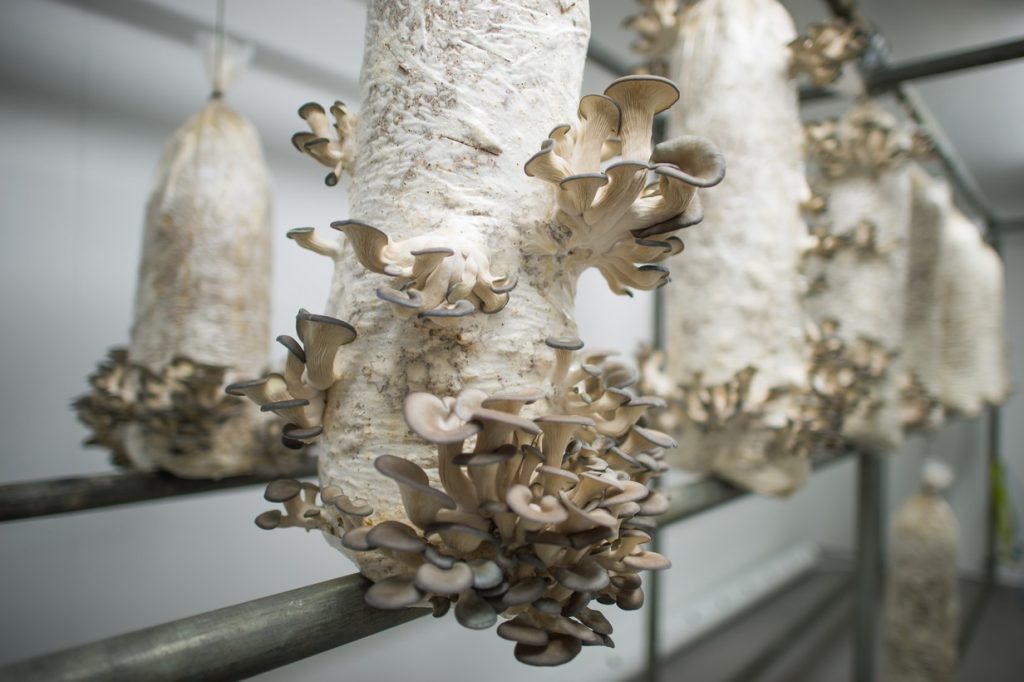
Which Mushrooms Should You Grow?
We find that oyster mushrooms are almost universally the best type of mushrooms for new growers to start with.
They’re easy to grow, they grow quickly and they’re in high demand. They also have relatively low production costs associated with growing them.
There are lots of different oyster varieties including pink, yellow, brown, white and blue. Growing a variety of different oyster mushrooms makes for an eye-catching display at farmer’s markets.
See our article Oyster Mushrooms 101: A Complete Guide To Oyster Mushrooms for an overview of the different types that you can grow.
Other gourmet mushroom varieties that are popular among both chefs and consumers are shiitake, king oyster and lion’s mane.
Our article The 5 Easiest Mushrooms to Grow is a good place to look for some other varieties too.
Medicinal mushrooms are another option to consider. Mushrooms like reishi, turkey tail and chaga are very popular due to their health benefits.
Medicinal mushrooms are typically sold dried or powdered, so you can also sell them online to a national or international customer, as opposed to just locally.
We recommend avoiding button mushrooms, portabella mushrooms and chestnut mushrooms.
These are the most commonly cultivated mushrooms on a large commercial scale. It’s difficult to compete on price with the massive button mushroom farms that already exist.
How To Grow Mushrooms
If you want to have a successful business that sells mushrooms, then you’ll need to get comfortable with growing them!
Here’s a basic overview of the steps in growing mushrooms. Specifically oyster mushrooms in this example.
1. Order Your Spawn, Substrate and Materials
You’ll need to get at least your spawn, substrate and bags to start growing mushrooms.
We recommend starting with ready-to-inoculate spawn. You can start with a sterile culture, but there’s a lot more that can go wrong in the process and it’s not as beginner-friendly.
You’ll also need a substrate like wood chips or straw. We recommend straw. Plus bags to store everything in.
2. Get Your Substrate Ready
You’ll want to chop your straw or other substrate into small pieces. Then get it wet and heat it in boiling water for at least 30 minutes to pasteurize the substrate.
This will create a Low Tech pasteurization and kill off most other mold or fungi spores that could contaminate your mushroom bags.
Once you’ve pasteurized your substrate, spread it out on a clean table and let it cool down to room temperature.
We cover this process (and the rest of the mushroom farming process) in-depth in our Low Tech Mushroom Farming Course.
3. Pack the Substrate and Spawn Into Grow Bags
Put an inch or two of substrate into your bag. Then sprinkle a layer of spawn on top of it. Repeat these alternating layers until you’ve almost filled up the bag and then tie it shut.

4. Incubate Your Bags
Place your bags into an incubation room with the conditions that we discussed earlier. Be especially sure to cover up any cracks around windows or doors so that light can’t get in.
Once your bags are completely colonized with white mycelium, they’re ready to fruit.
5. Fruit Your Mushroom Bags
Once fully colonized, it’s time to move your bags to a fruiting room.
Optionally, you may want to shock the bags by placing them in a large tub of cold water for an hour or two before they go into the fruiting room.
Once your bags are hung up in the fruiting room, cut holes in the bag where the mushrooms can pin and grow out of.
Learn how to set up your fruiting chamber in our guide How to Build a Mushroom Fruiting Chamber: 7 Steps.
6. Harvest Your Mushrooms
When your mushrooms are ready to harvest, simply twist them off near the base of their stems.
With oyster mushrooms and most other varieties, there’s a narrow window that’s ideal for harvesting.
Harvest too early and your mushrooms won’t have reached their maximum size. Too late and your fruiting room will end up getting covered in spores.
It’s best to check on your mushrooms at least a couple of times per day when you suspect they’ll be ready to harvest soon.
Now you’ve got fresh mushrooms and all that’s left to do is sell them.
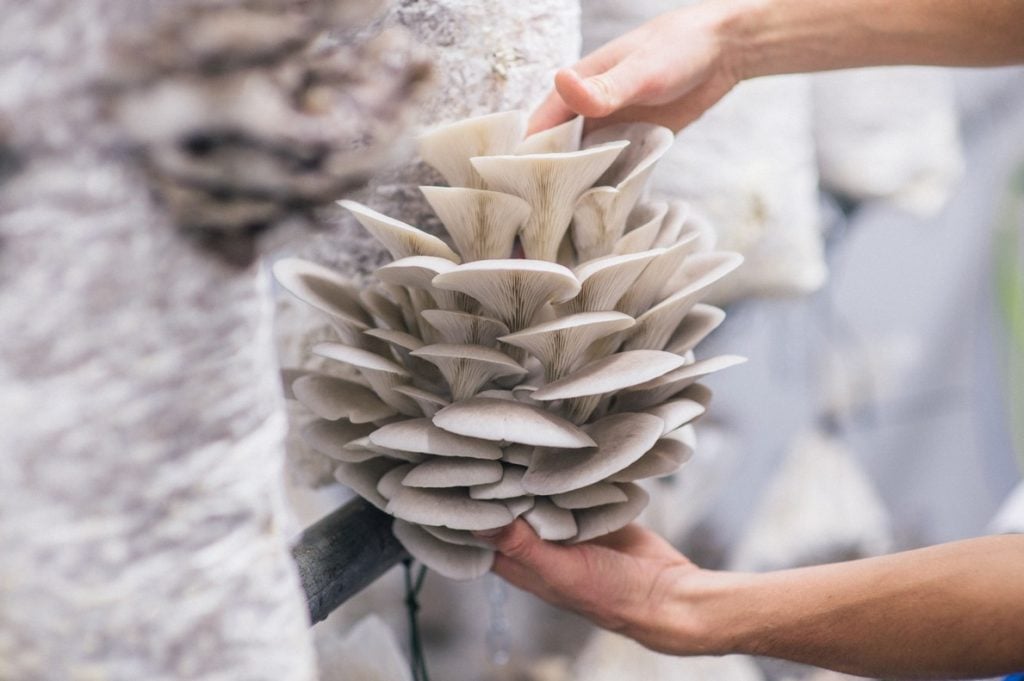
Common Mushroom Growing Problems
Here are some common mistakes made by new mushroom businesses and how to avoid or troubleshoot them.
1. Starting too big. There’s a good chance that you’ll run into problems and failures when first starting your mushroom growing business.
It’s best to fail small when just getting started, instead of having a catastrophic loss of a larger crop.
Be sure that you’re comfortable with the entire mushroom growing process and have been through it a few times before expanding your operations.
2. Investing too much in equipment from the start. Mushroom growing is one business that you can really bootstrap and start with minimal investment.
While it might be nice to have all the best equipment, it’s possible to run your business without most of it at the beginning.
Figure out which equipment is absolutely needed for the techniques and varieties that you want to use. Try to do without anything extra in the beginning if possible.
You can always reinvest profits back into the business later on, instead of needing to take out a loan in the beginning.
3. Trying to learn it all yourself. There are plenty of people out there who have all of the knowledge you’ll need already.
There’s no need to try to figure everything out from scratch. Our mushroom growing courses can help to dramatically cut the learning curve.
Plus you can learn from our mistakes and avoid wasting your own time or money.
Final Thoughts
Growing mushrooms can be a rewarding, sustainable and profitable business.
Like any type of business, you don’t want to go into it blind.
It’s important to create a business plan and do a thorough analysis.
That includes figuring out who your customers are, what types of mushrooms will sell in your area and what your expenses will be.
Our Low Tech Mushroom Farming Course is the best and most comprehensive resource out there for someone looking to start their own mushroom business.
It contains over 80 detailed videos covering every step of the process. Plus an online community with over 500+ other small scale mushroom growers from more than 50 countries. To find out more, download our free eBook. You’ll receive free training videos and full information about the course.
